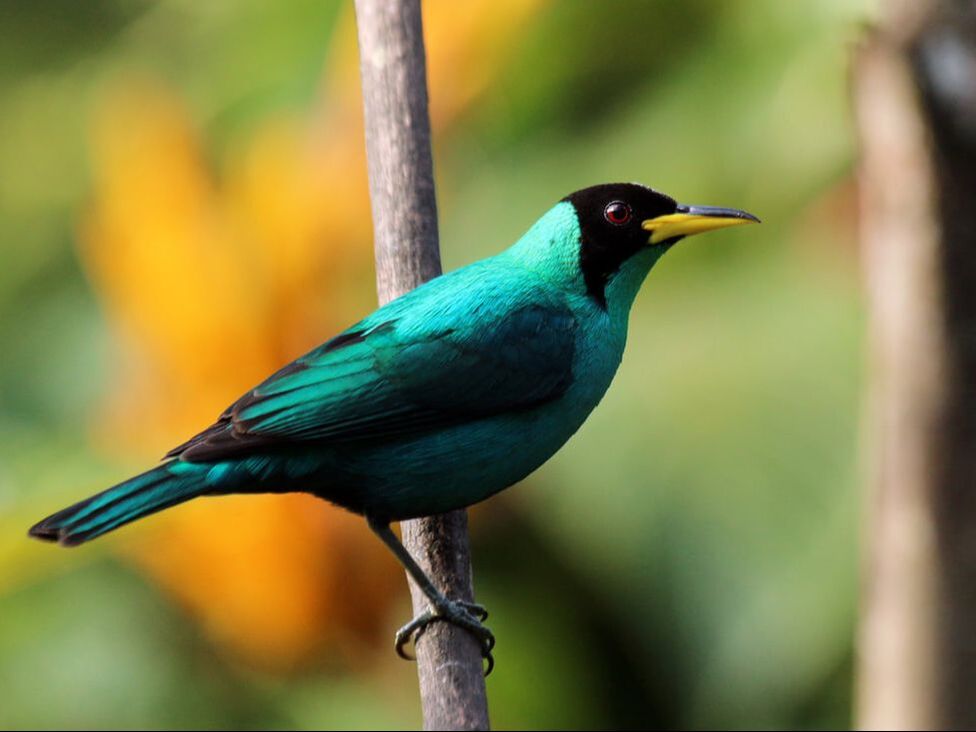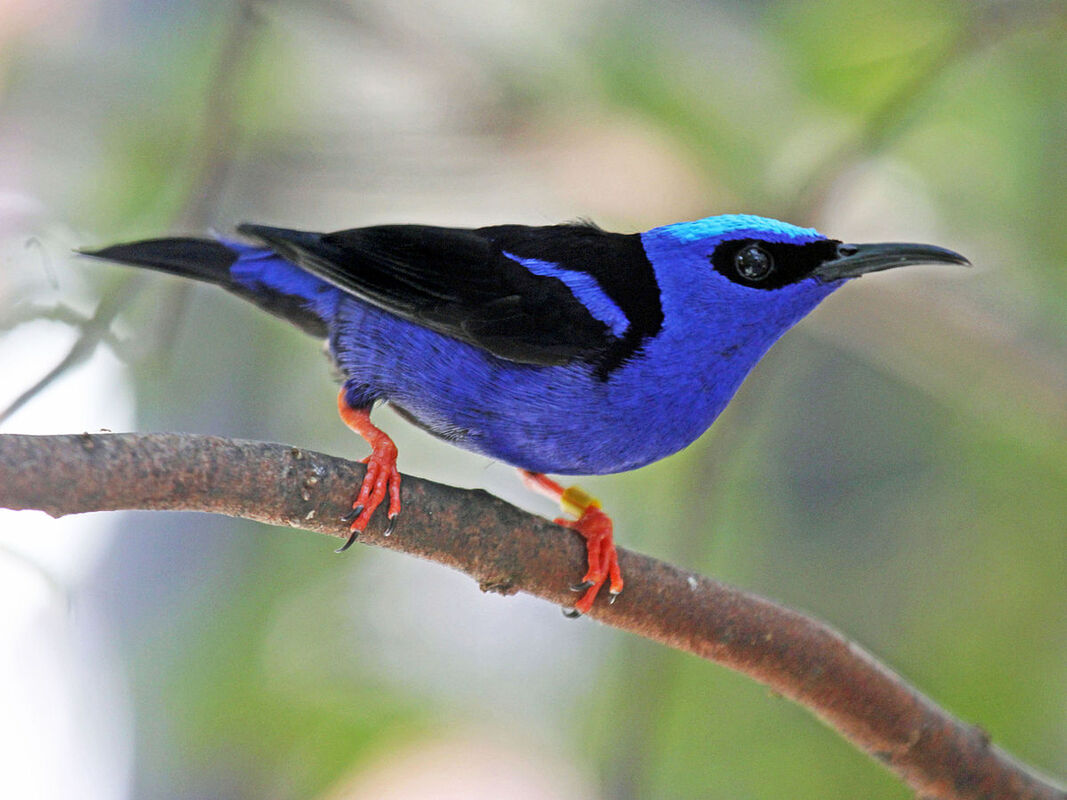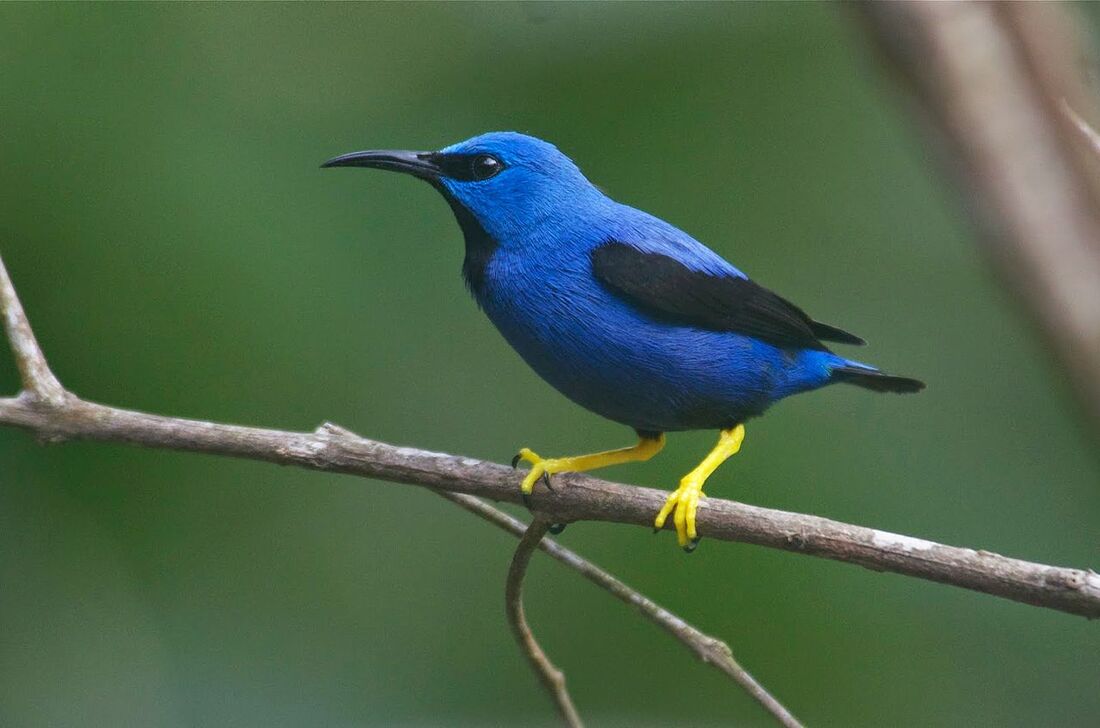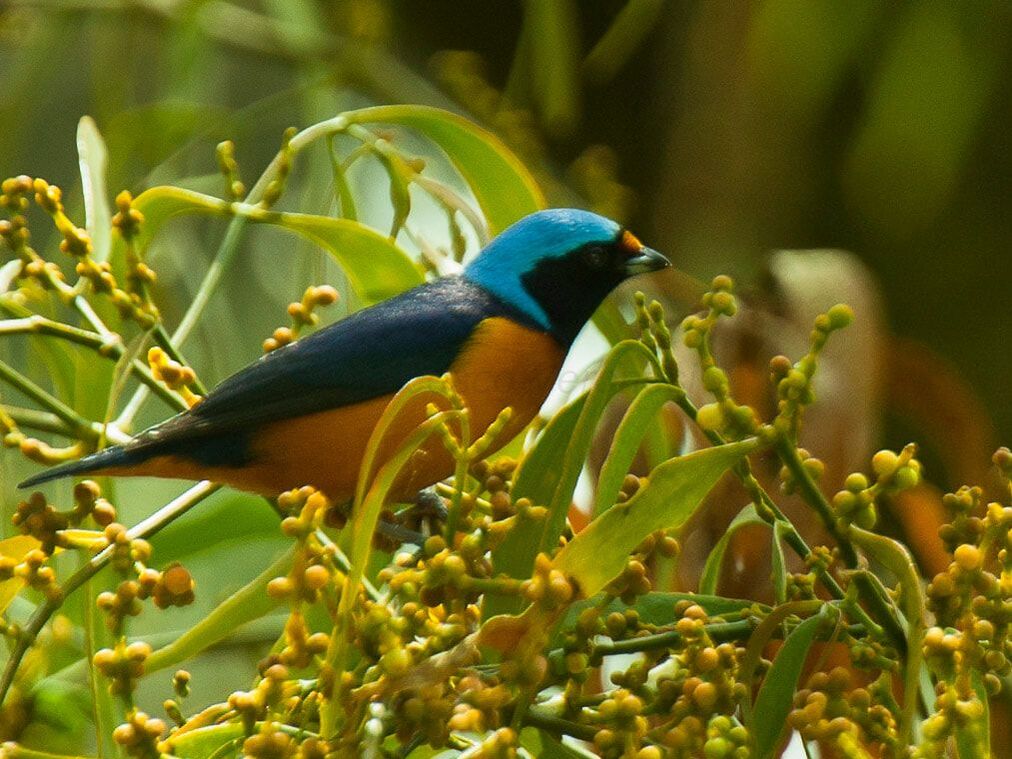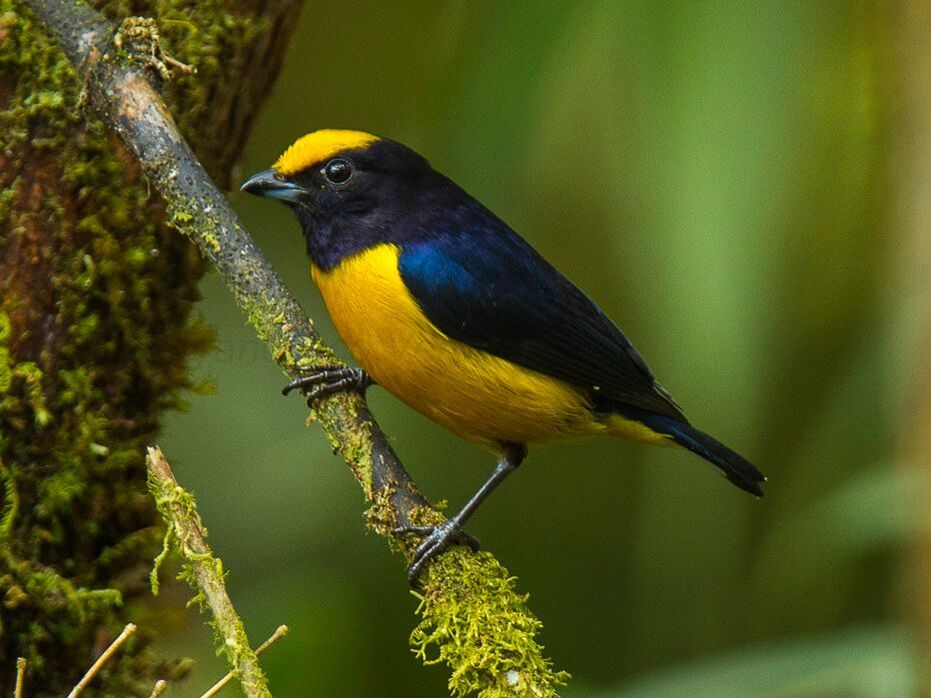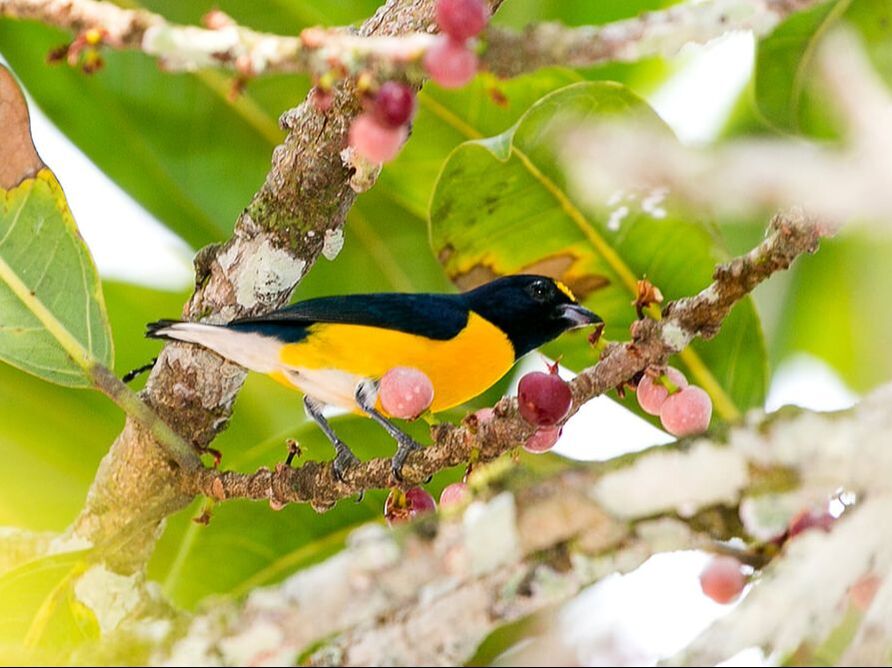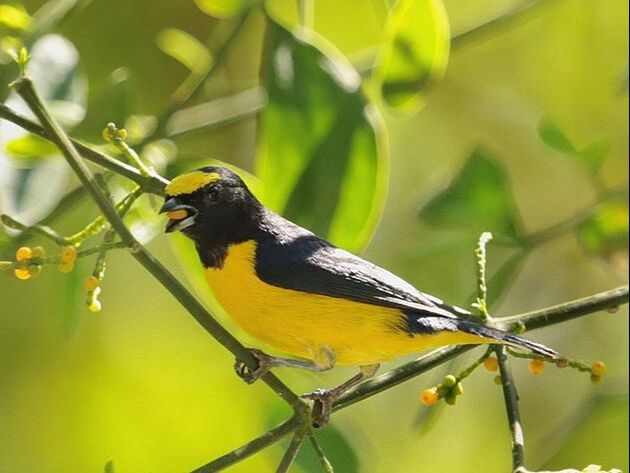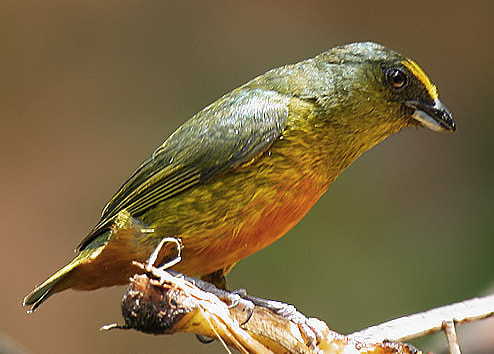Honeycreepers & Euphonias - in Belize
Green Honeycreeper
Green Honeycreeper - Very attractive small tanager of humid tropical lowlands. Found in humid evergreen forest edges, plantations, and gardens; at times with mixed-species feeding flocks of honeycreepers and euphonias. Often in pairs, feeding at all levels in fruiting trees and bushes. Note the short, curved bill. Males are a unique green-blue color with black hood and a banana yellow beak. Female resembles female Red-legged Honeycreeper but is larger, brighter, uniform green, with yellow lower bill and grayish legs.
BELIZE HABITAT - Canopy and sub-canopy; broadleaf forest interior. Where can I find this bird in Belize? Uncommon to fairly common resident in Toledo (except northeast), west Stann Creek and south half of Cayo and disjunctively in west Orange Walk. |
Red-Legged Honeycreeper
Red-Legged Honeycreeper - Small, warbler-like tanager of tropical lowlands. Favors forest edge, woodland, and semi-open areas with taller trees. Often occurs in small groups, sometimes larger flocks, usually in the canopy of flowering trees, where it probes for nectar with its long bill. Red legs are bright on male, dullest on young birds. Male is blue in breeding plumage, with a turquoise cap; female and non-breeding male are greenish overall with faint streaking on the chest. In flight, the underside of the wings flash bright sulphur-yellow.
BELIZE HABITAT - Canopy and sub-canopy; broadleaf forest interior and edge (less often, pine forest); open areas with scattered trees. More widespread than other honeycreepers. Frequents flowering and fruiting trees. Where can I find this bird in Belize? Uncommon to seasonally common on mainland nearly throughout. Mostly resident, but present only from April to September in Corozal and numbers diminished elsewhere in winter. |
Shining Honeycreeper
Shining Honeycreeper - Small, warblerlike tanager of foothills and adjacent lowlands. Found in humid evergreen forest and edge. Feeds at all levels, mostly in the canopy of fruiting and flowering trees and bushes. All plumages have more strongly decurved bill and shorter tail than the more common Red-legged Honeycreeper. Also note distinctive yellow legs. Male is deep blue overall with black throat and wings. Female has a necklace of bluish streaks across chest.
BELIZE HABITAT - Canopy and sub-canopy; broadfleaf forest interior and edge. Frequents flowering trees. Where can I find this bird in Belize? Fairly common resident at higher elevations in Maya Mountains of Cayo, Stann Creek and Toledo; local and generally scarce in foothills (i.e. Cockscomb Basin). |
|
Elegant Euphonia - Very small, handsome finch of foothills and highlands. Occurs in a wide range of habitats, from humid pine-oak forests to brushy hedgerows in farmland, the common denominator being mistletoe. Usually in pairs or small groups, in or near mistletoe clumps, from which it sings persistently, but can be hard to spot. Plumage distinctive: male deep rusty below with black throat and turquoise-blue hood; female greenish overall with turquoise-blue hood and rusty forehead. Formerly known as Blue-hooded Euphonia.
BELIZE HABITAT - Canopy and sub-canopy; submontane and foothill broadleaf forest interior and edge. Where can I find this bird in Belize? Uncommon and local resident in Maya Mountains and the Vaca Plateau Cayo; recently near Gallon Jug Orange Walk. |
Yellow Throated Euphonia - Tiny finch of tropical lowlands and foothills, mainly in humid areas. Found in forest canopy, adjacent clearings with trees, gardens. Usually in pairs, sometimes small groups that associate readily with other euphonias, especially when feeding at mistletoe. Male has rich yellow throat and underparts (lacks black throat of male Scrub Euphonia); female has pale grayish throat and yellow sides creating a vested appearance. Young male looks like female with an adult male head stuck on.
BELIZE HABITAT - Canopy and sub-canopy; broadleaf forest interior and edge (less often, pine forest); oepn areas with scattered trees. More widespread than other honeycreepers. Frequents flowering and fruiting trees. Where can I find this bird in Belize? Uncommon to seasonally common on mainland nearly throughout. Mostly resident, but present only from April to September, in Corozal and numbers diminshed elsewhere in winter. |
White-Vented Euphonia
White Vented Euphonia - Tiny, generally uncommon finch of humid evergreen forest and edge in tropical lowlands. Usually in pairs, which associate readily with other euphonias, especially when feeding at mistletoe. Male has black head and throat with yellow forehead patch and white vent (vent yellow on Scrub Euphonias in same range). Yellow breast is richer, more golden yellow than Scrub Euphonia. Female rather drab but distinctive: pale grayish throat contrasts with dull yellowish breast and vent is white like male.
BELIZE HABITAT - Canopy and sub-canopy; broadleaf forest interior and edge. Where can I find this bird in Belize? Uncommon resident in Maya Mountains and foothills north to south east Cayo and south west Stann Creek; also in coastal south Toledo. One record from near Belize City. |
Scrub Euphonia
Scrub Euphonia - Tiny finch of tropical lowlands and foothills, especially in drier areas. Found in woodland, forest edge, and clearings with trees. Usually in pairs, sometimes small groups that associate readily with other euphonias, especially when feeding at mistletoe. Male has black head and throat with yellow forehead patch; female rather drab, but lacks vested appearance of female Yellow-throated Euphonia, which is slightly larger.
BELIZE HABITAT - Sub-canopy and canopy; second growth scrub, pine woodland and pine oak savannas, broadleaf forest edge. Where can I find this bird in Belize? Fairly common resident in north, uncommon in south third; occasional visitor or uncommon resident on Ambergris Caye, once on Caye Caulker. |
Olive-Backed Euphonia
Olive Backed Euphonia - Very small finch of humid evergreen forest and edge in tropical lowlands. Usually in pairs, which associate loosely with other euphonias, especially when feeding at mistletoe or fruiting trees. Both sexes bronzy green overall with deep rusty vent (extending into belly stripe on male). Forehead patch yellow on male and deep rusty on female.
BELIZE HABITAT - Canopy and sub-canopy; broadleaf forest interior and edge. Frequents bromeliads. Where can I find this bird in Belize? Common resident on mainland north to north Orange Walk and north Belize. |

